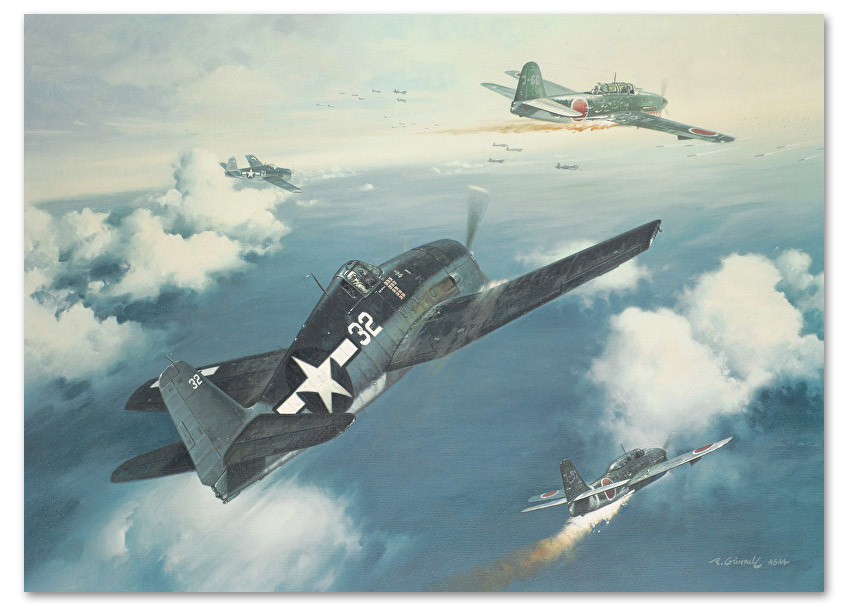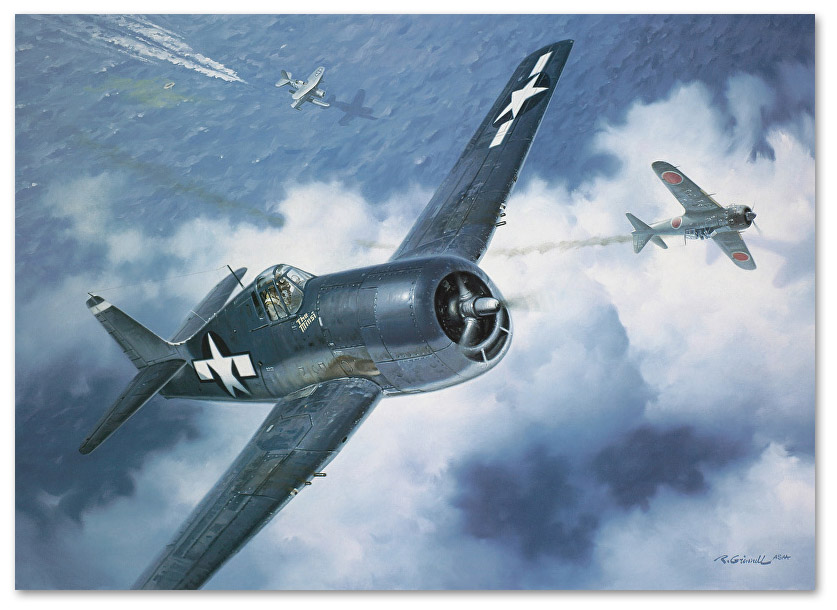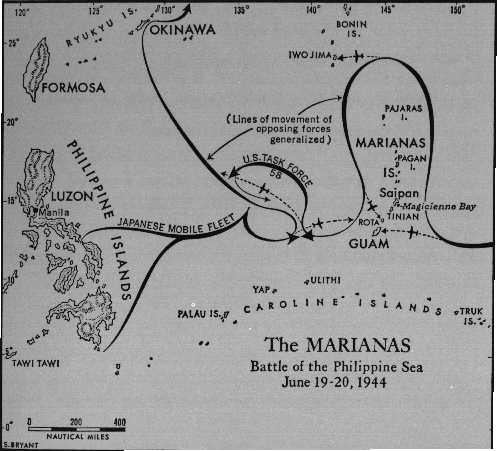|
Posted on 06/22/2003 4:32:16 AM PDT by snippy_about_it
|
|
 are acknowledged, affirmed and commemorated.
|

| Our Mission: The FReeper Foxhole is dedicated to Veterans of our Nation's military forces and to others who are affected in their relationships with Veterans. We hope to provide an ongoing source of information about issues and problems that are specific to Veterans and resources that are available to Veterans and their families. In the FReeper Foxhole, Veterans or their family members should feel free to address their specific circumstances or whatever issues concern them in an atmosphere of peace, understanding, brotherhood and support.
|
|
|
|
19-20 June 1944 In September 1943 Japanese Imperial Headquarters resolved that in the near future the entire strength of their fleet would be deployed against the US Navy in a great decisive battle, and that in this battle the enemy fleet would be destroyed "in one blow." By the Spring of 1944 Japanese commanders had decided that the decisive encounter was imminent, and on 3 May the order for the operation - "A-Go" - was issued.  The A-Go Plan was based on the assumption that when the great battle came about the American fleet would be carrying out an offensive in the Central Pacific and that the Japanese would therefore have the advantage of numerous island air-bases within range of the scene of battle. The Japanese command knew that their forces would suffer from a considerable inferiority in carrier airpower, and they were therefore depending on their own land-based air-power to redress the balance. On June 15 1944 the initial US landings in the Marianas took place - on the island of Saipan. The Japanese had been hoping and expecting that the American attack would come in the Carolines or the Palaus, to the south of the Marianas, and closer to the main Japanese sources of fuel. Their land-based aircraft had been disposed accordingly - with relatively weak forces in the Marianas. Thus the great operation began with a setback for Japanese strategic hopes. Another blow to their expectations was that the threat from American submarines restricted Japanese carriers to their anchorage, so that they were unable to conduct proper flight training in the run-up to the battle.  Lieutenant Vraciu shot down six Japanese aircraft in less than eight minutes. One aircraft was destroyed as it tried to crash into an American destroyer. A preliminary US carrier strike in the Marianas on June 11 persuaded Admiral Toyoda, C-in-C of the Combined Fleet, that this was where the next landings would take place, and accordingly Japanese forces began to converge on the Marianas for the decisive battle. Their main groupings made rendezvous on June 16 in the western part of the Philippine Sea and completed refuelling on June 17. By the evening of that day Admiral Ozawa, commanding the Japanese forces, had reasonably accurate intelligence of the composition of the US fleet. A few minutes after midnight 17/18 June, Ozawa - in the tradition of the Japanese Navy - issued a final exhortation to all the ships of his fleet : "This operation has an immense bearing on the fate of the Empire. It is hoped that all forces will do their utmost and attain results as magnificent as those achieved in the Battle of Tsushima." The Japanese forces had been sighted by American submarines as early as June 15. By June 16 Admiral Spruance, commanding the US Forces (the Fifth Fleet), was satisfied that a major sea battle was approaching, and made plans accordingly. By the afternoon of June 18 Task Force 58 (the Fast Carrier Task Force under Admiral Mitscher) was concentrated near Saipan ready to meet the Japanese fleet.  More intelligence of the Japanese fleet's movements, from submarines and radio intercepts, came in during June 18. Shortly before midnight 18/19 June Admiral Nimitz sent Spruance a message from Pacific Fleet Headquarters indicating that the Japanese flagship was approximately 350 miles to the west-south-west of Task Force 58. Shortly afterwards Mitscher sought Spruance's permission to head west during the night to what - as Mitscher and his staff considered - would be an ideal launch position for an all-out dawn air attack on the enemy force. However, Spruance refused. Throughout the run-up to the battle he had been concerned that the Japanese would try to draw his main fleet away from the landing area using a diversionary force, and would then make an attack around the flank of the US carrier force - an "end run" - hitting the invasion shipping off Saipan. Such methods were a long-standing part of the Japanese Navy's tactical doctrine . Spruance was intensely conscious that protection of the invasion shipping was his paramount responsibility, and should therefore take precedence over the destruction of the Japanese fleet. Moreover, the Admiral considered, as he was later to observe, that "if we were doing something so important that we were attracting the enemy to us, we could afford to let him come - and take care of him when he arrived." In effect this was to be what happened during the battle.  Mitscher and his staff were aghast at Spruance's decision. Captain Arleigh Burke, the Task Force 38 Chief of Staff, bitterly commented that it "meant that the enemy could attack us at will at dawn the next morning. We could not attack the enemy." The Fifth Fleet Commander was adversely criticised by many naval officers after the battle and continues to be condemned - by some writers - to the present day. A still common allegation is that Spruance decided as he did because he was not an aviator, and therefore must have had an inadequate understanding of the principles of carrier warfare. At dawn - 0430 - on 19 June Task Force 58 was steaming E by N about 150 miles to the WSW of Saipan and about 100 miles to the NW of Guam. This huge fleet - with nearly 99,000 personnel on board - was disposed in five groups - the four carrier groups and Admiral Lee's Battle Line.  First came the three stronger carrier groups in a north-south line abreast, with the centres of the groups 12-15 miles apart. Due west of the middle group of this line steamed Task Group 58.7 - Lee's Battle Line - with the weakest carrier group - Harrill's Task Group 58.4 - sailing within visual distance to the north of it. The carrier groups were each disposed in a circle four miles in diameter (with the carriers in the centre of their respective groups but having plenty of room for safe manoeuvering while under attack), and the Battle Line was arranged in a circle about 6 miles in diameter, with the battleship Indiana as guide at the centre of this circle. The formation covered an area of sea roughly 35 miles by 25 miles. At 0530 the task force turned north-eastwards, directly into the wind, and began to launch combat air patrol, anti-submarine patrols, and search missions. At 0619 Spruance ordered a change of course to WSW, hoping thereby to place the fleet closer to the as-yet unlocated enemy forces. But the carriers had to turn back into the wind whenever they were launching aircraft, and at 10am Task Force 58 was in almost exactly the same position as it had been at dawn.  The A-Go plan called for about 500 aircraft to be available on the land bases in the Marianas. In fact - partly because of the damage inflicted by the American carrier forces in strikes made between 11 June and 18 June - there were a mere 50 or so, all of them based on the island of Guam. The first attack of the day came at 0550 when a scouting Zero from Guam attacked the picket destroyers of the Battle Line and was shot down. The next action took place over Guam when Hellcats from the light carrier Belleau Wood, investigating a radar contact, encountered Japanese aircraft taking off from Orote Field. At 0807 more Japanese aircraft were detected by radar, heading towards Guam. These were reinforcements flying in from other Japanese-held islands. Fighters were vectored out to intercept them and there was continuous fighting over and around Guam for nearly an hour. 35 Japanese aircraft were shot down, but others were still taking off from Orote when the Hellcats received a "Hey Rube!" signal (calling them back over the carriers) from the task force flagship. Task Force 58 had detected large numbers of unidentified aircraft approaching from the west. These were the planes of the first attack wave from Ozawa's carriers, 68 or 69 aircraft in all.
|
Snippy already pointed you to our Taffy 3 thread.
P.S. Any relation to the "Colonel Flagg" from M.A.S.H.?


The weather was clear with scattered cumulus clouds off the coast of Saipan on the morning of 19 June, 1944. As part of Task Force 58 protecting the Marianas landings, Fighting Squadron 16 was expecting an attack from the 400-plane Japanese carrier force. At 10:30 bogeys were picked up on radar approaching in several large groups and twelve Hellcats were launched from the USS Lexington to intercept the Japanese force. Twelve-victory ace, Lieutenant Alex Vraciu was one of the pilots in that group.
Leading a division of four Hellcats, Vraciu experienced engine problems and couldn't climb past 20,000 feet, but requested a vector from the fighter director and was put onto a line of Yokosuka D4Y2 Judy dive bombers. In the eight minute tail-chase, Vraciu splashed six. The air battle became known as the Great Marianas Turkey Shoot - Task Force 58 Hellcats destroyed over 300 Japanese aircraft. The following day, Alex Vraciu claimed his 19th and last victory, a Zeke.
|
 HOUSE TO HOUSE — Members of 1st platoon, 3rd Battalion, 327th Infantry Regiment, A Company, 101st Airborne Division (Air Assault), move from house to house conducting cordon searches and looking for weapons in Mosul, Iraq, June 18, during Operation Guliani. This is one of the many ongoing missions of the 101st Airborne Division during Operation Iraqi Freedom. U.S. Army photo by Spc. Kieran Moore  RAINBOW FLAVOR — U.S. Army Spc. Jay Gerson of the 450th Civil Affairs Battalion (Airborne) gives a little girl from the village of Dai Kalay a taste of the rainbow, some Skittles candy, during a Team village patrol in the Kandahar Province of Afghanistan, June 14. The Team Village patrols made up of Task Force Devil soldiers and Romanian forces provide situation awareness, assessment of village needs, distribution of humanitarian aid and gather passive intelligence in support of Operation Enduring Freedom. U.S. Army photo by Staff Sgt. Leopold Medina Jr.  GATHERING INTEL — Soldiers of 450th Civil Affairs Battalion (Airborne), 301st Psychological Operations Company (Airborne), and Romanian forces, meet with the villagers from the Baybbam Darrah village June 14. The soldiers ask questions, thereby gathering passive intelligence and assessing the village's needs in addition to providing situation awareness during a Team Village patrol. The Team Village patrol also distributes humanitarian aid consisting of school supplies as well as shoes and clothing in support of Operation Enduring Freedom. U.S. Army photo by Staff Sgt. Leopold Medina Jr.  THROUGH THE STREETS — The 101st Airborne Division's Maj. Michael Albertson, the interim mayor of Al Hamdania, Iraq's liaison officer, greets local children during a walk through the streets with city council members, June 16. Defense Dept. photo by Sgt. Michael Bracken, U.S. Army.  HANDSHAKE — U.S. Army Maj. Michael Albertson, the interim mayor's Liaison Officer from the 101st Airborne Division (Air Assault), talks with local children as he walks with several city council members in Al Hamdania, Iraq, during Operation Iraqi Freedom June 16. U.S. Army photo by Sgt. Michael Bracken  A Marine sniper team with 2nd Battalion, 23rd Marine Regiment, trudges through sliding dirt to move into a shooting position during a security halt along the route to Baghdad. Among the units returning from war, 2nd Battalion, 23rd Marine Regiment may change the future of Marine Corps Reserve units. U.S. Marine Corps photo by Gunnery Sgt. Mark Oliva.
|
LOL. Lucky for you it's a short drive!
The U. S. invasion of the Mariana Islands on 15 June 1944 brought the Japanese fleet out fighting for the first time since the naval battles of Guadalcanal in the fall of 1942. Determined to force a showdown battle, Admiral Soemu Toyoda ordered a combined fleet of 9 carriers and 18 battleships and cruisers to attack the U. S. warships protecting the landing on Saipan. Here Admiral Raymond Spruance, Commander of the U. S. Fifth Fleet, organized defensive preparations and sent 15 fast carriers of Task Force 58, commanded by Vice Admiral Marc A. Mitscher, west to intercept the Japanese, then only 90 miles away.
The battle opened early on 19 June with an attack on Task Force 58 by Japanese land-based planes from Guam and Truk. Hellcat fighters from our carriers destroyed 35 enemy fighters and bombers. The remainder of the battle was fought by 430 Japanese carrier planes attacking the 450 planes of Task Force 58 in four fierce waves.
At the end of the eight-hour onslaught, only 100 of the enemy planes returned to their carriers. The rest had been destroyed in the most decisive aerial combat in history. Thirty American planes were lost in what the fliers called the "Marianas Turkey Shoot." No damage was done to the U. S. Fifth Fleet's ships.

On the night of 19 June, the Japanese turned to the northwest and fled with the U. S. carriers in hot pursuit. On the evening of the 20th, Mitscher decided he could get no closer and launched 209 planes. The Japanese were now 300 miles away. This would be to the extreme limit of the fighters' range, plus they would be returning in the dark.
The success of the raid was just so-so. The Japanese carrier HIYO was sunk, but 20 of our planes were shot down and 80 more did not make it back. Of the 80 that went down, 51 pilots were saved. I was a crewmember of USS IRWIN (DD 794), and we picked up one of them.
It was a tricky, sticky thing. Not only were they low on fuel, but in the dark they had to find a carrier. They were coming back not in the formations we were used to seeing, but straggling in groups of two or three. Planes started to go down. Others circled, trying to find their carriers. It was then that Vice Admiral Marc Mitscher gave a four word order that made him the most beloved admiral in the Navy: "Turn on the lights." Immediately, every ship in the fleet turned on its searchlights and pointed the beams skyward. The glow from nearly 200 searchlights could be seen for a hundred miles.
As soon as a pilot knew he was going down, he would pick out a ship and flick his landing lights on and off. When we saw one of them coming, the crew on the port side searchlight depressed the beam to the water. The pilot could now judge how much elevation he had, and we on the ship could keep his plane in sight .... In he went.
Chief Boatswain Mate Jorgensen commanded the whaleboat and was alongside the plane, which was still afloat, in less than two minutes. The pilot was standing in the cockpit and jumped in when the boat came alongside. A crash landing at sea, and he didn't even get his feet wet!
Supper was late that night. Somehow those remarkable men in the galley stirred up a small cake, lit a candle, took it to the Officers' Mess and presented it to the young flier. It was his 22nd birthday.
Disclaimer: Opinions posted on Free Republic are those of the individual posters and do not necessarily represent the opinion of Free Republic or its management. All materials posted herein are protected by copyright law and the exemption for fair use of copyrighted works.